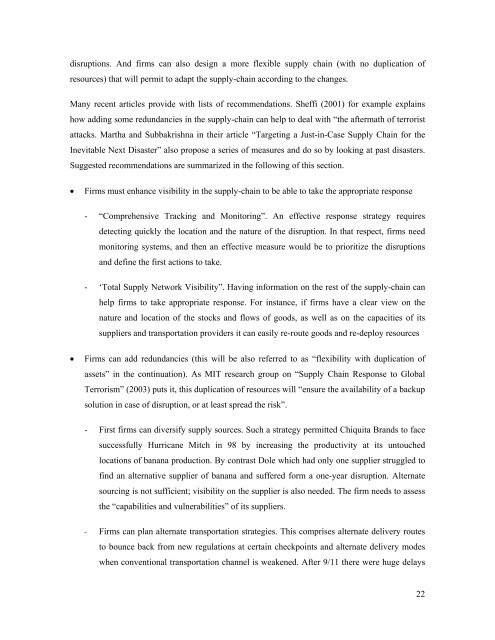Managing Risks of Supply-Chain Disruptions: Dual ... - CiteSeerX
Managing Risks of Supply-Chain Disruptions: Dual ... - CiteSeerX
Managing Risks of Supply-Chain Disruptions: Dual ... - CiteSeerX
You also want an ePaper? Increase the reach of your titles
YUMPU automatically turns print PDFs into web optimized ePapers that Google loves.
disruptions. And firms can also design a more flexible supply chain (with no duplication <strong>of</strong>resources) that will permit to adapt the supply-chain according to the changes.Many recent articles provide with lists <strong>of</strong> recommendations. Sheffi (2001) for example explainshow adding some redundancies in the supply-chain can help to deal with “the aftermath <strong>of</strong> terroristattacks. Martha and Subbakrishna in their article “Targeting a Just-in-Case <strong>Supply</strong> <strong>Chain</strong> for theInevitable Next Disaster” also propose a series <strong>of</strong> measures and do so by looking at past disasters.Suggested recommendations are summarized in the following <strong>of</strong> this section.• Firms must enhance visibility in the supply-chain to be able to take the appropriate response- “Comprehensive Tracking and Monitoring”. An effective response strategy requiresdetecting quickly the location and the nature <strong>of</strong> the disruption. In that respect, firms needmonitoring systems, and then an effective measure would be to prioritize the disruptionsand define the first actions to take.- ‘Total <strong>Supply</strong> Network Visibility”. Having information on the rest <strong>of</strong> the supply-chain canhelp firms to take appropriate response. For instance, if firms have a clear view on thenature and location <strong>of</strong> the stocks and flows <strong>of</strong> goods, as well as on the capacities <strong>of</strong> itssuppliers and transportation providers it can easily re-route goods and re-deploy resources• Firms can add redundancies (this will be also referred to as “flexibility with duplication <strong>of</strong>assets” in the continuation). As MIT research group on “<strong>Supply</strong> <strong>Chain</strong> Response to GlobalTerrorism” (2003) puts it, this duplication <strong>of</strong> resources will “ensure the availability <strong>of</strong> a backupsolution in case <strong>of</strong> disruption, or at least spread the risk”.- First firms can diversify supply sources. Such a strategy permitted Chiquita Brands to facesuccessfully Hurricane Mitch in 98 by increasing the productivity at its untouchedlocations <strong>of</strong> banana production. By contrast Dole which had only one supplier struggled t<strong>of</strong>ind an alternative supplier <strong>of</strong> banana and suffered form a one-year disruption. Alternatesourcing is not sufficient; visibility on the supplier is also needed. The firm needs to assessthe “capabilities and vulnerabilities” <strong>of</strong> its suppliers.- Firms can plan alternate transportation strategies. This comprises alternate delivery routesto bounce back from new regulations at certain checkpoints and alternate delivery modeswhen conventional transportation channel is weakened. After 9/11 there were huge delays22
















